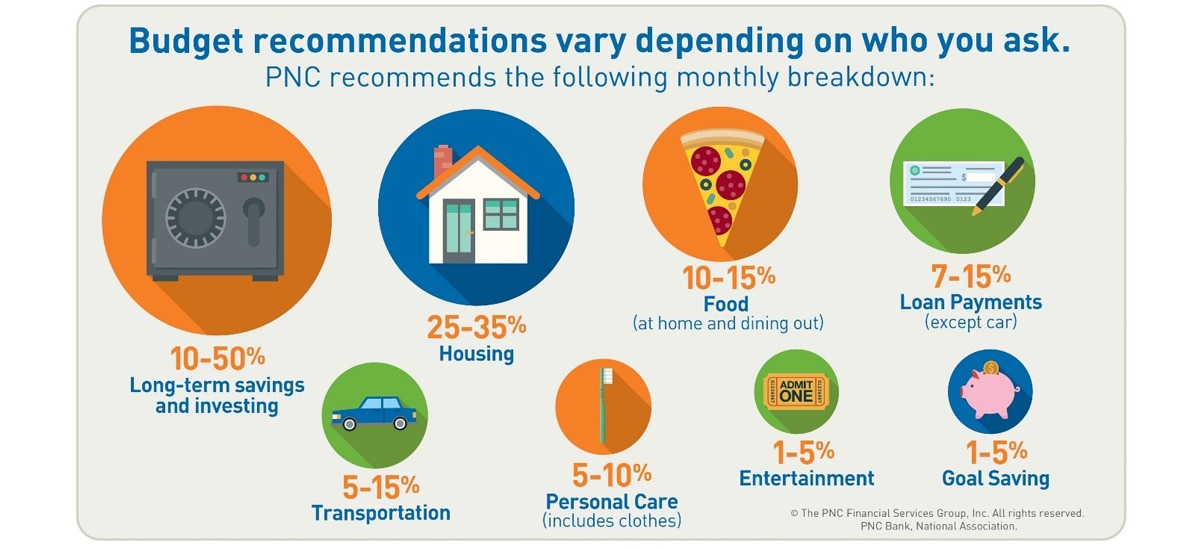
After earning your paycheck, the last thing you want to do is look at your monthly bank statement and wonder where all your hard-earned cash went. If you’ve ever found yourself in this frustrating situation, the good news is it can be remedied.
A 2021 FINRA report found that higher financial literacy is linked with more successful financial capability.[1] This finding speaks to the importance of learning about financial education, as well as using financial tools like budgets, to spend and save smart.
Smart spending might seem daunting, but there are tips and technology available to help you navigate the process — here’s how to start.
Earmark Your “Fun Money”
If it seems like your money is gone as soon as you earn it, building a budget can help. It can motivate you to control your spending and carve out room for longer-term financial goals, like starting and building your savings. In this way, budgets are a foundational tool for meeting your financial goals and living the lifestyle you wish to have.
Your budget provides a framework for financial responsibility that allows you to allocate your paycheck to pay for needs like rent or groceries. Budgets don't have to be all work and no play; you can also incorporate some “fun money,”[2] which can reward you for building financial acumen and saving more money. With fun money, you can strategically allocate some of your cash to enjoyable purchases for things like concert tickets or a new bike.
Break the Cycle of Recreational Overspending
Even with the best budget to guide your spending, it can be easy to fall into a pattern of rewarding yourself more than you're saving. At the beginning of 2023, Bankrate reported that almost half of American adults say they have less savings or no savings compared to a year ago.[3]
Recreational overspending can happen for a host of reasons, some personal and others related to the environment you live in, for example:
- One-third of Americans report they would go into debt to support their favorite sports team.[4]
- FINRA highlights that historic financial inequities still exist across some populations.[5]
- There are generational preferences when it comes to spending on alcohol, entertainment, and food.[6]
To ensure “fun money” stays fun, and to curtail overspending, you can begin to take inventory of how you save for and spend your recreational budget.
Get Reacquainted with Your Virtual Wallet®
There’s a time and place for pen-and-paper budgeting, but utilizing technology in budgeting can improve planning ahead, as well as making in-the-moment decisions.
Smart spending starts with downloading the PNC Mobile Banking app.[7] The Spending + Budgets tool in Virtual Wallet® products helps makes it easy to group your spending into categories, like “gas” and “restaurants,” so you know at a glance where your money is going. You can also create a budget for each category and set up notifications to keep your recreational spending in check.
As you look over your transactions from the past few months and analyze your recreational spending, ask yourself:
- Where did I spend more money than I realized or intended?
- Which purchases left me satisfied?
- Are there any purchases I regret?
The answers should give you some insight into how fulfilling your recreational spending really is — and where there’s room for adjustment. Take note of any areas in which you may be over- or underspending your recreational funds, and make sure notifications are turned on in your budgets tool to help track your spending.
Compare Your Actual Spending to Your Ideal Spending
Once you have the big picture for your recreational funds, it’s time to compare your spending goals to your actual spending.
Picture your ideal month. What would you plan for? Which purchases would make you feel fulfilled? What purchases could you do without?
Now, take note of any differences between your ideal month and your current spending. Maybe you recognize that you’re spending a ton of cash on expensive delivery fees when what you really want is a night out with friends or a date night.
If overspending is an issue for you, can you reflect on times when you’re most likely to overspend? Knowing this information can be hugely beneficial to avoid these settings, or to decide beforehand what you’re comfortable with dollarwise, in terms of an event or purchase.
Cut Your Spending Without Crushing Your Lifestyle
By now, you should see your recreational spending falling into two main categories: Purchases that fit into your ideal month, and purchases that eat into your budget without much payoff.
The latter group is where you can trim your budget without feeling deprived. So ask yourself what you can cut. If you’re paying for a streaming service out of habit, for example, canceling might disrupt your schedule for a few days — but after a week, you might not miss it.
Further, trim your budget by looking for free or low-cost alternatives to activities you enjoy. A homemade picnic with your family might replace the novelty of ordering in at a fraction of the cost, freeing up more of your recreational budget for what you really want.
Create a Wish List — And Give Yourself Permission To Spend
Use the ideal month exercise to decide which purchases will be most fulfilling and make a plan to budget for them. Highlight purchases you crave the most, including items or experiences that are likely to have a lasting impact on your well-being and fit your current budget. These are great candidates to budget for right now.
As long as you can afford it, give yourself permission to plan for these high-impact purchases. It may seem counterintuitive, but shelling out for what you really want can break the cycle of low-impact spending. Opting for several lower-cost alternatives that offer short-lived satisfaction can sometimes leave you spending way more than you intended, so treat yourself to what you truly want from the start. If you really love it, and it fits your budget, even a pricey purchase is worth it.
Save for Longer-Term Wants
Chances are that not everything on your wish list fits your budget right now. That’s okay! Make room in your recreational budget for some savings, and you’ll be able to reward yourself soon.
Virtual Wallet® can make it easy to reward yourself. Use the Savings Goals feature to create goals in your Reserve or Growth accounts for longer-term recreational spending. And use Savings Rules to move funds into those accounts on a regular basis, so you can easily stow some recreational funds anytime you get paid.
Consider saving some of your recreational budget, even when you don’t have a specific purchase in mind. It can build up a “fun money” nest egg to cover purchases outside your normal budget when you unexpectedly find something that fits the bill.
Finally, remember to savor the moment when you treat yourself. Taking control of your finances means achieving the life you want with no financial regrets, and you deserve to savor it.







